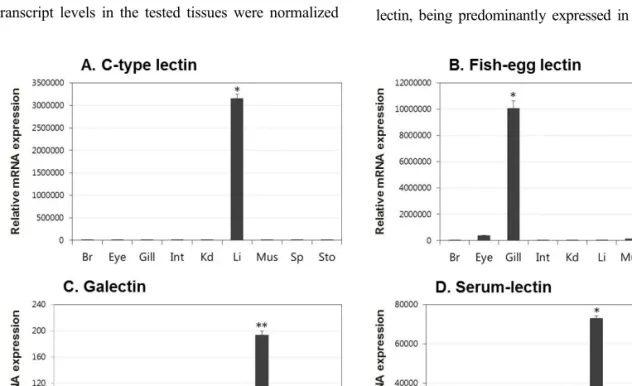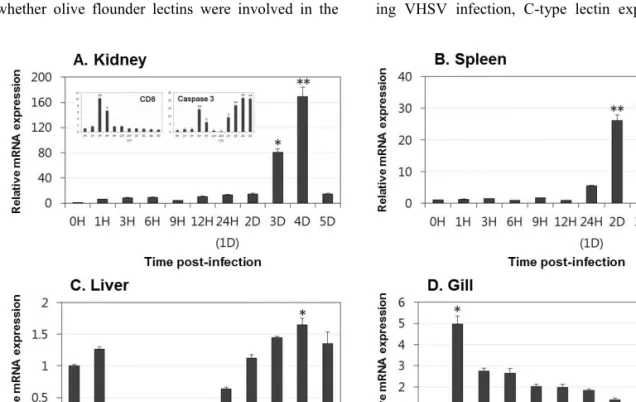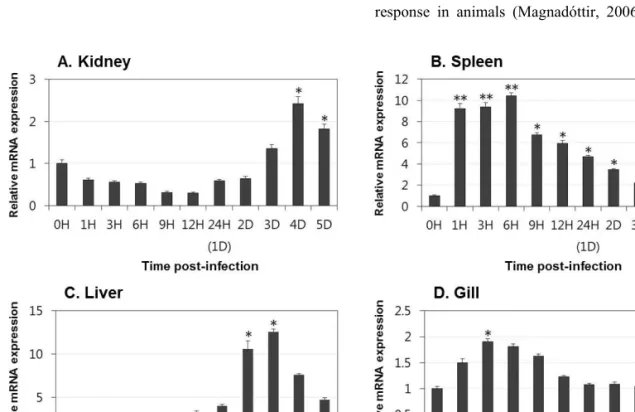J. Fish Pathol., 29(1) : 13~23 http://dx.doi.org/10.7847/jfp.2016.29.1.013
Fish larvae are free-living in the aquatic environ- ment following fertilization and are frequently ex- posed to pathogenic microorganisms. Innate immunity constitutes the first line of defense against microbial invasion based on pattern recognition; thus, maternal immunity is particularly important in fish (McGreal et al, 2004; Holmskov et al, 2003; Vasta et al, 2004;
Fujita et al, 2004). Lectins are carbohydrate-binding proteins that act as central components of the innate immune response in animals. They are able to recog- nize and bind exposed carbohydrates on the cell sur- face or sugar moieties on glycoproteins and glyco-
lipids. Additionally, lectins exhibit a variety of bio- logical functions in innate immunity, including self and non-self recognition (Vasta et al, 1994; Arason, 1996), promotion of tumor metastasis (Kim et al, 1998), stimulation of respiratory burst (Gasparini et al, 2008), agglutination of microbial cells (Argayosa and Lee, 2009; Fock et al, 2000) and in the cell adhe- sion, migration, apoptosis (Kasai et al, 1996; Ni and Tizard, 1996), encapsulation (Koizumi et al, 1999) and opsonization through binding to pathogen-asso- ciated molecular patterns (PAMPs) (Yu et al, 2013).
In particular, fish lectins identify and stimulate the uptake of pathogens by phagocytes and facilitate com- plement-mediated cell lysis and elimination through natural killer cells (Hoffmann et al, 1999).
Transcriptional analysis of olive flounder lectins in response to VHSV infection
Young Mee Lee, Jae Koo Noh
†, Hyun Chul Kim, Choul-Ji Park, Jong-Won Park, Gyeong Eon Noh, Woo-Jin Kim and Kyung-Kil Kim
Genetics and Breeding Research Center, National Institute of Fisheries Science (NIFS), 81-9, Geojenamseo-ro, Nambu-myeon, Geoje-si, 53334, Gyeongnam, Korea
Lectins play significant roles in the innate immune responses through binding to pathogen-associated molecular patterns (PAMPs) on the surfaces of microorganisms. In the present study, tissue distribution and expression analysis of olive flounder lectins were performed after viral hemorrhagic septicemia virus (VHSV) challenge. Fish egg lectin and serum lectin were found to be predominantly expressed in the gills and liver, these results indicate that the transcript expression of olive flounder lectins is concentrated in immune-related tissues. Following a VHSV challenge, an overall increase in the transcript levels of the genes was observed and the expression patterns were distinctly divided into early and later responses during VHSV infection. In conclusion, olive flounder lectins are specifically expressed in immune-related organs and induced in both the immediate and long-lasting immune responses to VHSV in the olive flounder. These results indicate that lectins may be play important roles in the host defense mechanism and involved in the innate and adaptive immune response to viruses in fish.
Key words: Gene expression, Olive flounder, Paralichthys olivaceus, Lectin, Viral hemorrhagic septicemia virus (VHSV), Adaptive immune response
†
Corresponding author: Jae Koo Noh
Tel: 82-55-639-5813; Fax: 82-55-639-5809
E-mail: jae9noh@korea.kr
Dendritic cells (DCs) exhibit important functions in the initiation and differentiation of immune re- sponses and serve as a link between the innate and adaptive immune systems, and some lectins are known to be involved in the adaptive immune re- sponse (Wassaman et al, 1986; van Vliet et al, 2008;
Zhu et al, 2013). In adaptive immunity, lectins func- tion as regulators by recognizing bacterial or viral pathogens on DCs, which involves cytokine signal transduction, lymphocyte maturation and polarization against the invading pathogens (den Dunnen et al, 2010).
Recently, several members of the lectins have been studied in various defense mechanisms related to pathogen infection. C-type lectins have been reported in zebra fish (Danio rerio) (Zheng et al, 2015), rough- skin sculpin (Trachidermus fasciatus) (Yu et al, 2013), grass carp (Ctenopharyngodon idellus) (Liu et al, 2011), Scophthalmus maximus (Zhang et al, 2010), orange-spotted grouper (Epinephelus coioides) (Wei et al, 2010), Japanese flounder (Paralichthys oliva- ceus) (Kondo et al, 2007), tongue sole (Zhou and Sun, 2015) and common carp (Cyprinus carpio) (Savan et al, 2004); fish-egg lectins have been reported in rock bream (Oplegnathus fasciatus) (Kim et al, 2011); ga- lectins have been reported in roughskin sculpin (Trachidermus fasciatus) (Yang et al, 2013), Japanese flounder (Paralichthys olivaceus) (Liu et al, 2013), Atlantic cod (Gadus morhua) (Rajan et al, 2013), Korean rose bitterling (Rhodeus uyekii) (Kong et al, 2012) and sea bass (Dicentrarchus labrax) (Poisa- Beiro et al, 2009); and serum lectins have been re- ported in Trichogaster trichopterus (Fock et al, 2001) and spotted halibut (Verasper variegatus) (Hatanaka et al, 2008).
Olive flounder, Paralichthys olivaceus, is widely cultured in Korea and other Southeast Asian coun- tries, but viral diseases have affected the aquaculture industry, causing significant economic losses. Viral hemorrhagic septicemia virus (VHSV) was identified as the most important pathogen infecting olive floun-
der in the last decade and is one of the major patho- gens in olive flounder aquaculture. However, there is little available information based on integrated ob- servations of flounder lectins in the immune responses against virus infection. In this study, we analyzed the tissue distribution and temporal expression profile of olive flounder lectins in the immediate and long-last- ing immune response against VHSV infection.
Materials and Methods
Fish maintenance and tissue samples Olive flounders were obtained from the Genetics and Breeding Research Center of the National Institute of Fisheries Science (NIFS, Geoje, Republic of Korea) and were maintained in a 10-ton flow- through tank at 20±1°C with continuous aeration un- der a natural photoperiod. The olive flounders were anaesthetized prior to experiments involving tissue collection and pathogen injection, and samples were collected under aseptic conditions. Abnormal and dis- eased fish were excluded in all of the experiments.
Tissue samples, including brain, eye, gill, intestine, kidney, liver, muscle, spleen and stomach samples, were dissected from ten healthy olive flounders (total length of approximately 10 cm, 4~5 months old) and immediately frozen in liquid nitrogen, followed by storage in a -80°C freezer until use.
VHSV challenge
The olive flounders were divided randomly into
two groups for the VHSV challenge experiment: a
control group and a challenged group. The control
and challenged fish were injected with 100 μl of phos-
phate buffered saline (PBS) or a VHSV suspension
(10
4.8TCID
50virus/ fish), respectively (Kong et al,
2009). The temperature to which the experimental
fish were subjected was controlled at 15°C using a
re-circulation system, without flow and feeding. The
kidney, spleen, liver and gill were collected under
aseptic conditions at 0, 1, 3, 6, 9, 12 and 24 hours
and at 2, 3, 4 and 5 days post-injection. Tissues from each fish were pooled together in equal amounts and frozen in liquid nitrogen. The pooled tissues were ground using a homogenizer, and equal amounts of the ground tissues from each fish were mixed and subjected to RNA extraction.
Total RNA extraction and cDNA synthesis Total RNA was extracted from the ground fish tis- sues with TRI solution (BSK-Bio Co.) as described in the manufacturer's protocol. The total RNA was treated with DNase-I (Sigma-Aldrich) to remove ge- nomic DNA contamination. The RNA concentration was measured spectrophotometrically (BioTek, Gen 5.2.), and RNA quality was assessed via electro- phoresis in 1% agarose gels.
cDNA was synthesized with Transcriptor First Strand cDNA Synthesis Kit (Roche) using an oligo (dT)
18primer. To synthesize cDNA, the reverse tran- scription reaction was conducted as follows: a mixture containing 1 µg of total RNA, the oligo (dT)
18primer and RNase-free dH
2O was held at 65°C for 5 min, then placed on ice for 5 min, after which 5x Tran- scriptor Reverse Transcriptase Reaction Buffer, Pro- tector RNase Inhibitor, a dNTP mixture, Transcriptor Reverse Transcriptase and RNase-free dH
2O were added. The final reaction was carried out for 1 h at 50°C and 5 min at 85°C. Specific primers for olive flounder lectins and β-actin were designed using the
Primer 3 program. The primers used for qRT-PCR are shown in Table 1.
Quantitative real-time PCR
Expression analysis of olive flounder lectins was conducted using quantitative real-time PCR with spe- cific primers, and the mRNA levels of β-actin were used as an internal control. Quantitative real-time PCR was conducted using the ABI 7500 Real-time Detection System (Applied Biosystems) according to the manufacturer’s instructions. The final reaction volume contained 10 μl of Fast SYBR Green PCR Master Mix (Applied Biosystems), 100 ng of cDNA, 0.3 μl of each of the forward and reverse primers.
The amplification procedure consisted of an initial de- naturation step for 20 seconds at 95°C, then 40 cycles of 3 seconds at 95°C and 30 seconds at 60°C, fol- lowed by a final dissociation stage. Dissociation curve analysis of the amplification products was performed after quantitative real-time PCR to confirm the specif- icity of the PCR products.
The relative expression ratio of the target gene ver- sus the β-actin gene was calculated using the 2
−ΔΔCtmethod (Pfaffl, 2001). All samples were analyzed with three duplicates, and all data are presented in terms of relative mRNA levels, expressed as the mean
± SE (n = 3). Statistical analyses were performed with SPSS 17.0 software (SPSS Inc.) and the data were subjected to one-way analysis of variance (ANOVA).
Table 1. PCR primers used in this study
Target gene GenBank acc. no.
Product
length Sense primer Antisense primer Ta
aβ-actin CD8 Caspase 3 C-type lectin Fish-egg lectin Galectin Serum lectin
HQ386788 AB082957 JQ394697 BR000404 FJ211414 AF220550 GU165767
218 108 115 214 169 150 171
GAGCGTGGCTACTCCTTCAC TAAGGGCAACACTAACACAGG ACATCATGACACGGGTGAAC AGAATGGAAATGGGTGGACA GGAGGTGATGGTCAGGTTGT AAGGTCGGACAGACCATGAC CAAAACCCTGGTCAGCAACT
AGGAAGGAAGGCTGGAAGAG ATGAGGAGGAGGAGAAGGAG TCCTTCGTCAGCATTGACAC TGAAGGTTGGTGTCAGTGGA CAATTCCCCAGCATCCATAC GTTGCACACCACTGCATTCT TTGTTGTCAGCACAGCCTTC
60 56 58 60 60 60 60
a





